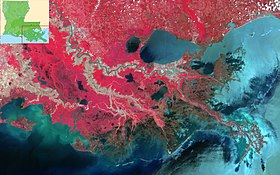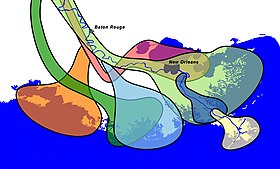User:Interiot/Sandbox/Mississippi River Delta
- For other uses, see Mississippi Delta (disambiguation).



The Mississippi River Delta is the modern area of land (the river delta) built up by alluvium deposited by the Mississippi River as it slows down and enters the Gulf of Mexico. The deltaic process has, over the past 5,000 years, caused the coastline of south Louisiana to advance gulfward from 15 to 50 miles (24 to 80 km).
It is a biologically significant region, comprising 3 million acres (12,000 km²) of coastal wetlands and 40% of the salt marsh in the contiguous United States. It is also a commercially significant region, supporting the economy of New Orleans with significant shipping traffic, providing 16 to 18% of the US oil supply, and providing 16% of the US's fisheries harvest, including shrimp, crabs, and crayfish.
Recent influences
[edit]Every thousand years or so, the Mississippi river has changed course. Each Mississippi River deltaic cycle was initiated by a gradual capture of the Mississippi River by a distributary which offered a shorter and steeper route to the Gulf of Mexico. After abandonment of an older delta lobe, which would cut off the primary supply of fresh water and sediment, an area would undergo compaction, subsidence, and erosion. The old delta lobe would begin to retreat as the gulf advanced, forming bayous, lakes, bays, and sounds.
750 years ago, the Mississippi abandoned its main course through the Lafourche Bayou and began flowing in the current direction to the area where New Orleans is located. 550 years ago, it began extending further out into the Gulf of Mexico.
In the last 100 years or so, the river has been diverting more of its flow to the Atchafalaya River, which branches off some 60 miles (95 km) northwest of New Orleans. In the 1950’s, engineers observed that the Mississippi would soon abandon its current channel as the mainstream, and instead migrate to the Atchafalaya. Because there is a considerable amount of economic development along the current path of the Mississippi, and because extensive flooding and evacuation would occur in the new area, Congress instructed the Army Corps of Engineers to maintain the then-present 70% / 30% distribution of water between the Lower Mississippi and the Atchafalaya River channels respectively. They did so by building the Old River Control Structure which consisted of massive floodgates that could be opened and closed as needed at the entrance to the Old River.
Man-made changes to other parts of the Mississippi River, for purposes of maintaining a navigation channel, have a pronounced effect on the Delta region. Dams, artificial channeling, and land conservation measures have caused a decrease in sediment carried into the delta region, decreasing the rate of build up of the Delta.
At the same time, the rate of loss of the Delta has recently increased past the rate of build up, causing a net loss of wetlands in the Delta area. The rise of the sea level has also caused increased erosion, as fresh water vegetation previously protecting against erosion dies due to the influx of salt water. Subsidence has increased.
History
[edit]Build-up of the Gulf of Mexico shoreline due to the outflow of the Mississippi River has been occurring in a periodic fashion since the late Jurassic period. This same process is responsible for build up of the larger Mississippi embayment, however the delta region is the most recent, ecologically distinct, portion.
The latest cycle of delta formation can be traced to the pleistocene epoch, when a large amount of ocean water was tied up in glaciers. The sea level was 300-400 feet (~100m) below present level, and causing the mouth of the Mississippi to be located further out into the Gulf of Mexico. 10,000 years ago, the glaciers began to melt, and the sea level began to rise. 5,000 - 6,000 years ago, the sea level stabilized, and formation of recognizable modern deltas began.
Lake Pontchartrain was formed during the evolution of two separate delta lobes. 4000-3800 years ago, the Cocodrie lobe * expanded over the area where New Orleans presently resides, forming the lake's southern shore. 2800-2600 years ago, the St. Bernard lobe * pushed forward and completed the lake's eastern shoreline. [1]
See also
[edit]Sources
[edit]- Kolb,van Lopik (1958). Geology of the Mississippi River deltaic plain, southeastern Louisiana. Technical Report 3-483. Vicksburg, MS: U.S. Army Corps of Engineers Waterways Experiment Station. (PDF, 6.86MB) [2]
- LA Coast / USGS — Mississippi River Delta Basin
- Emporia State University — The Mississippi Embayment, Quaternary Geology
- USGS, Status and Trends — Coastal Louisiana
- Detrital Depositional Sequences of the Mississippi River Deltaic Plain, George F. Hart, Ph. D.
- USGS — Geologic History of the Lake Pontchartrain Basin
- Louisiana State University — Wetlands: Impacts of Energy Development in the Mississippi Delta
- USGS — Louisiana Coastal Area - Ecosystem Restoration Plan
External links and sources
[edit]- Google Maps - satellite imagery
- US Army Corps of Engineers, New Orleans District
- U.S. Geological Survey - Mississippi Delta, Changes Over Time
- U.S. Geological Survey - Causes of hot-spot wetland loss in the Mississippi delta plain
- U.S. Geological Survey - Louisiana Coastal Wetlands: A Resource At Risk
- NOW with Bill Moyers - Losing Ground
- visibleearth.nasa.gov - True-color image hilighting sediment outflow from delta front
- lacoast.gov - Land loss map of the delta front
- Barataria Terrebonne National Estuary
